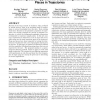Free Online Productivity Tools
i2Speak
i2Symbol
i2OCR
iTex2Img
iWeb2Print
iWeb2Shot
i2Type
iPdf2Split
iPdf2Merge
i2Bopomofo
i2Arabic
i2Style
i2Image
i2PDF
iLatex2Rtf
Sci2ools
SAC
2008
ACM
2008
ACM
A clustering-based approach for discovering interesting places in trajectories
Because of the large amount of trajectory data produced by mobile devices, there is an increasing need for mechanisms to extract knowledge from this data. Most existing works have focused on the geometric properties of trajectories, but recently emerged the concept of semantic trajectories, in which the background geographic information is integrated to trajectory sample points. In this new concept, trajectories are observed as a set of stops and moves, where stops are the most important parts of the trajectory. Stops and moves have been computed by testing the intersections of trajectories with a set of geographic objects given by the user. In this paper we present an alternative solution with the capability of finding interesting places that are not expected by the user. The proposed solution is a spatiotemporal clustering method, based on speed, to work with single trajectories. We compare the two different approaches with experiments on real data and show that the computation of s...
| Added | 28 Dec 2010 |
| Updated | 28 Dec 2010 |
| Type | Journal |
| Year | 2008 |
| Where | SAC |
| Authors | Andrey Tietbohl Palma, Vania Bogorny, Bart Kuijpers, Luis Otávio Alvares |
Comments (0)

